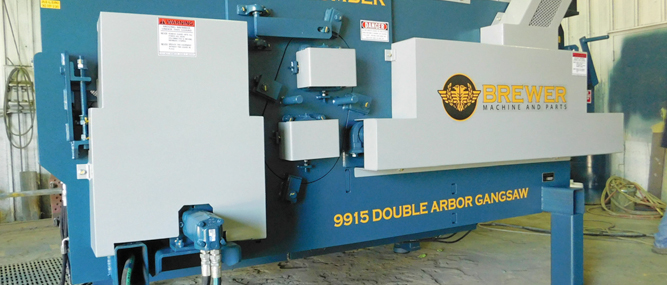Brewer Machine and Parts has gained significant insight into gang saws through 50 years of manufacturing and helping customers overcome obstacles. This experience can be valuable not only in solving operational issues but potentially preventing them entirely.
The challenge we most often encounter is when customers struggle to balance short-term versus long-term production goals. If impressive daily output is gained by neglecting preventative maintenance, untimely replacement of worn components or exceeding equipment capacity, then profitability will be harmed through premature equipment failures, unplanned downtimes and reduced equipment lifespan.
Another common administrative error is not allowing a sufficient learning curve when introducing new machines into operations. Productivity plans should include a gradual increase while operators and maintenance crews get to know the equipment.
Since safety should be a priority of every business, employees should be taught and trained to comply with all safety decals and operator manuals. Before any maintenance procedures are performed, blades and motors must come to a complete stop; safeguards should never be removed before lockout-tagout is executed. Operators and maintenance staff should be trained to know when components become worn and require attention or replacement. These steps will not only reduce the risk of injury but also aid profitability through greater operating efficiencies and quality products.
Correct top roll pressure is critical to daily operations. The pressure must be set low enough to firmly feed, hold the wood securely in the cut, keep the wood from chattering, and eliminate kick-back. However, if the rolls are adjusted too low, they will lay over blades, cut boards and jam the saw. First, make sure the bottom of the top infeed rolls and the planer head is level with the top of the material. Then adjust the top infeed rolls to 1/8-inch below the planer knives and the three top outfeed rolls to 1/4-inch, then 1/8-inch and 1/8-inch in order exiting the saw. Resist the urge to minimize scrap by running undersized material. These steps will increase usable output and reduce the risk of premature failure or breakage of expensive arbors and rolls.
Infeed rolls are canted towards the fence to properly align the wood going into the saw. Outfeed rolls are square with the fence to keep the sawn portion of boards from squeezing the outfeed side of the blade. Do not break the bearing shim welds, which are completed during factory testing, or misalignment will result. Should this occur, consult the operator’s manual or the manufacturer for realignment.
Trying to save money by not replacing worn rolls will actually cost you more. Rolls will wear quicker next to the fence, causing wood to feed towards the larger diameter and resulting in scrapping the inside board. Sawn wood can also be pulled back into the blade when traction on outfeed rolls is diminished. If material size allows it, flipping worn rolls will place the larger diameter against the fence, extending roll life as much as two times. Once this option is exhausted, it will be necessary to replace rolls.
Spacers should be carefully handled, monitored and stored. Despite being made of steel or aluminum, they are fragile and easily damaged. Blemishes, dents, warps, burrs and rust can cause blades to quickly loosen, resulting in wobble, vibration, wider kerf, bore wear and arbor bowing.
Blade tolerances should be closely maintained not only for quality cuts but also to avoid unnecessary machine wear. Tip-to-body from side-to-side should be within 0.002-inch of each other. Strobes from body-to-edge should be approximately 0.010-inch less than the distance from body-to-tip of saw tooth.
Monitor the amp meter, if supplied, for planer and arbor motors. When amp draw increases more than normal, blades should be immediately replaced. If amp meters are not available, blades should be replaced a minimum of every eight hours of running time.
When the saw is running at peak performance, operators hesitate to stop to clean and remove debris. However, if slivers of wood are allowed to build up, pressure on feed rolls can cause alignment problems, resulting in poor quality materials, unplanned downtime, and unbudgeted repair costs. The number of times per day that debris must be blown out of the saw depends on the strength of your dust removal system. All moving parts, such as bearings, rolls, arbors, etc., should be reviewed for debris build-up and cleaned accordingly.
Excluding labor, machines are the highest cost associated with running a mill. Utilizing the above tips is a great start to protect this investment. Contact a Brewer representative at 800-345-6516 for more ideas to maximize your company’s success.
Editor’s Note: Marty Fox is a senior sales representative for Brewer Machine and Parts, and Bryan Uzzle is a master builder. If you have questions about this article, contact Marty or Bryan at (800) 345-6516.




